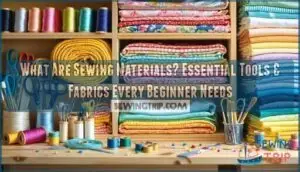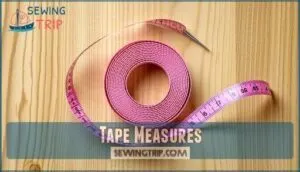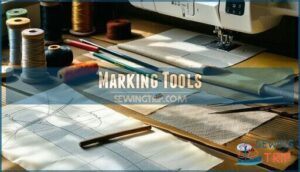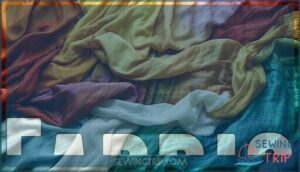This site is supported by our readers. We may earn a commission, at no cost to you, if you purchase through links.

You’ll require cutting tools like fabric scissors and rotary cutters, measuring instruments such as tape measures and rulers, plus marking tools for transferring patterns onto fabric.
Thread, needles, pins, and seam rippers round out your basic toolkit.
The fabric itself comes in countless varieties—cotton for beginners, silk for elegant garments, and specialty materials for specific projects.
Quality materials make the difference between amateur results and professional-looking creations.
Understanding which tools work best for different techniques can transform your sewing from guesswork into confident craftsmanship.
This understanding, combined with the right materials, is key to producing high-quality work, and successful stitching projects require careful selection of both tools and materials.
Table Of Contents
Key Takeaways
- You’ll need sharp cutting tools like fabric scissors and rotary cutters as your foundation—dull blades create frayed edges and frustrated sewers.
- Invest in quality measuring tools including a 60-inch tape measure and marking chalk since accurate measurements prevent fitting disasters and wasted fabric.
- Choose your fabric wisely by starting with forgiving cotton for beginners, then advancing to silk and specialty materials as your skills develop.
- Always pre-wash your fabric before cutting to prevent shrinkage surprises in your finished garments—this simple step saves countless projects from ruin.
Cutting Tools for Sewing
Beyond the basics, you’ll need sharp cutting tools that become extensions of your hands.
Quality sewing scissors with dedicated fabric-only use prevent dulling from paper cuts.
**Keep your fabric scissors sharp—they’re only as good as their last clean cut through cloth.
Rotary cutters paired with self-healing mats deliver precision for quilting projects, while pinking shears create decorative edges that resist fraying.
Master Rotary Cutter Safety by always closing blades after use.
Regular Scissor Sharpening Tips include professional maintenance annually.
Explore Specialty Cutting Tools like appliqué scissors for intricate work, and practice proper Cutting Mat Care through gentle cleaning and storage.
Consider purchasing specialized sewing scissors for superior performance.
Measuring and Marking Tools
Accurate measurements make the difference between a perfectly fitted garment and a sewing disaster.
You’ll need reliable tape measures for body measurements and marking tools to transfer pattern details onto your fabric with precision.
Tape Measures
A 60-inch seamstress tape is your go-to measuring tool for body measurements and curve measurement. This flexible ruler adapts to your body’s contours, unlike rigid rulers that can’t handle volume measurement accurately.
Essential features for effective sewing measurements:
- Dual markings – Both inches and centimeters for versatility
- Metal tips – Prevent fraying and guarantee precise alignment
- Non-stretch material – Fiberglass construction maintains accuracy
- Clear printing – High-contrast numbers resist fading over time
Replace your tape measure when markings fade or the material stretches. To guarantee accurate measurements, learn how to read tape.
Marking Tools
Your marking accuracy depends on choosing the right tools for each job.
The right marking tool transforms your fabric into a precise roadmap for perfect construction.
Marking chalk comes in wedges, pencils, or powder forms and brushes away easily after use.
Fabric marking pens offer precise lines but test pen erasers on scraps first to verify fabric compatibility.
Tracing wheels paired with tracing paper transfer pattern details quickly onto multiple fabric layers.
Tailor’s chalk remains the go-to choice for most sewers due to its versatility and clean removal properties.
Many sewers find specialized chalk useful for specific tasks and appreciate the use of marking chalk.
Fabric
Fabric forms the foundation of every sewing project, and choosing the right type can make or break your finished piece.
You’ll need to understand different fabric properties and prepare your material properly before you start cutting and stitching, which involves considering the complete concepts of the project.
Types of Fabric
Understanding fabric types helps you choose the right sewing materials for your projects.
Different fabrics offer unique characteristics that affect your finished garment’s appearance and performance.
Here are the main fabric categories you’ll encounter:
- Natural fibers – Cotton, linen, wool, and silk offer breathability and comfort
- Synthetic fibers – Polyester, nylon, and rayon provide durability and easy care
- Blended fabrics – Cotton-polyester mixes combine natural feel with synthetic strength
- Knit fabrics – Jersey and interlock stretch for comfortable, fitted garments
- Specialty fabrics – Denim, canvas, and chiffon serve specific design purposes
Consider fiber content, fabric weight, and weave structure when selecting materials. Print design adds visual interest while fabric durability determines longevity. Knowing a fabric’s grams per square metre helps determine its thickness and weight.
Preparing Fabric
Before you start cutting your fabric, proper preparation saves you from heartbreak later. Pre-washing fabrics prevents shrinkage disasters in finished garments.
Cotton and linen need machine washing in cold water, while wool requires gentle steaming. After washing, check grainline alignment by pulling fabric edges straight.
Fabric pressing with an iron removes wrinkles and creates smooth cutting surfaces. Use your ironing board to press seams flat before adding interfacing or batting.
Stabilizing fabric through proper pressing guarantees accurate pattern layout. This preparation step transforms unruly yardage into workable material that holds its shape throughout your project.
Many find specialty detergents helpful during this process, which is a crucial part of pre-washing fabrics and ensuring they are workable material with the right treatment, like gentle steaming.
Frequently Asked Questions (FAQs)
What materials are used for sewing?
Back when knights wielded needles like swords, you’ll need fabric, thread, needles, scissors, pins, measuring tape, and marking tools. These essentials form your sewing arsenal for any project.
What are basic sewing supplies?
You’ll need fabric scissors, measuring tape, pins, needles, thread, and a seam ripper for most projects. These essentials let you cut, measure, hold, stitch, and fix mistakes effectively.
What are sewing materials called?
Sewing materials encompass fabrics, notions, and tools you’ll use in projects.
They’re called supplies, notions, or materials – terms that cover everything from thread and needles to fabric and interfacing for your creations.
What are 5 examples of sewing?
You’ll find five key sewing techniques that form the foundation of most projects: hand sewing for precise detail work, machine sewing for efficient construction, embroidery for decorative elements, quilting for layered fabric projects, and alterations for fitting adjustments.
These techniques include embroidery for decorative elements, quilting for layered fabric projects, and alterations for fitting adjustments.
What thread types work best for different projects?
Like picking the right tool for the job, you’ll want polyester thread for durability on everyday projects, cotton for natural fabrics and quilting, and silk for delicate materials requiring finesse.
How do you choose the right needle size?
Match needle size to your fabric weight.
Use size 9-11 for lightweight fabrics, 12-14 for medium-weight materials, and 16-18 for heavy fabrics.
You’ll get cleaner stitches and prevent fabric damage when the needle fits properly.
Which presser feet are essential for beginners?
Don’t bite off more than you can chew—start with essentials!
You’ll need a zipper foot for installing zippers, buttonhole foot for creating buttonholes, and all-purpose foot for basic stitching.
These three versatile attachments handle most beginner projects efficiently.
Whats the difference between bobbins and spools?
Spools hold thread on top of your machine for the upper thread, while bobbins wind thread underneath for the lower thread that creates stitches together.
How should you organize your sewing workspace?
Creating an organized workspace transforms chaotic sewing sessions into smooth, productive experiences.
Keep your machine centered on a sturdy table, store tools within arm’s reach, and designate specific spots for cutting, pressing, and storage to maximize efficiency.
Conclusion
Gathering what’re sewing materials might seem like preparing for battle against fabric—and honestly, you’re not wrong.
Your success depends entirely on having quality cutting tools, accurate measuring instruments, and the right thread for your chosen fabric.
Cotton remains the most forgiving option for beginners, while silk demands respect and precision.
Remember, professional results come from understanding which materials work best together, not from hoping your dull scissors will magically cut clean lines.









